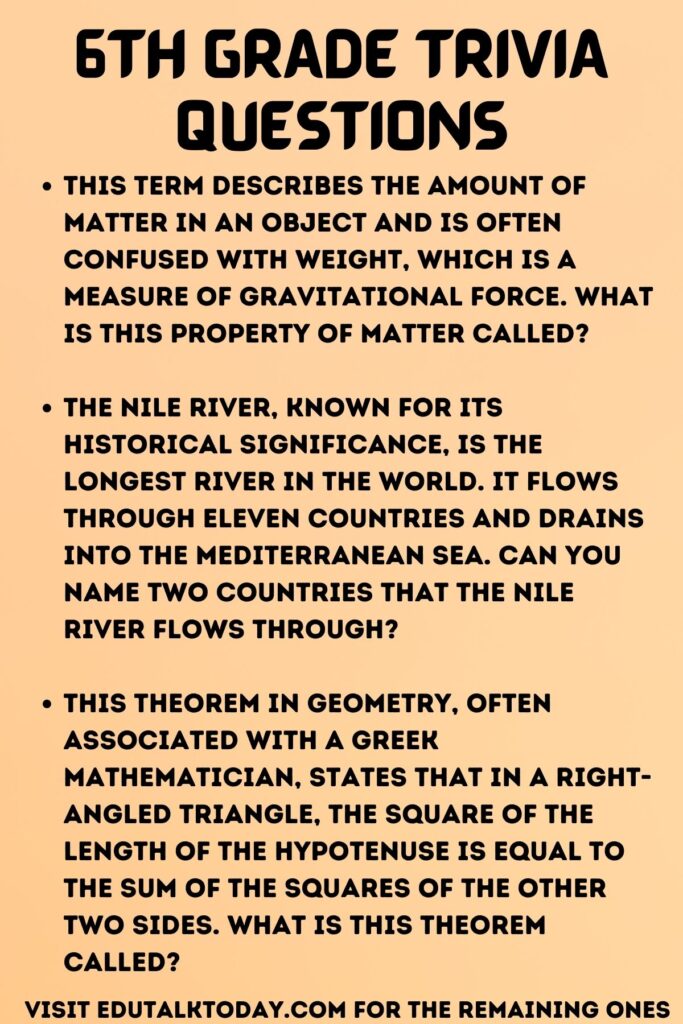36 6th Grade Trivia Questions

Welcome to our exciting world of trivia, specially crafted for 6th graders! This is the perfect place for curious minds who love to challenge themselves and learn new things. Whether you are a student in the 6th grade, a teacher looking for fun classroom activities, or a parent seeking to engage your child in an educational yet entertaining way, you’re in the right spot.
Our trivia questions cover a wide range of topics, from science and geography to history and literature, ensuring there’s something for everyone.
These questions are designed not only to test knowledge but also to spark interest and encourage further exploration in various subjects.
So, without further ado, let’s get started.
6th Grade Trivia Questions
- Astronomy: Our solar system has eight planets, but it wasn’t always that way. Once considered the ninth planet, this celestial body was reclassified in 2006. It is known for its unusual orbit and being part of a region of space known as the Kuiper Belt. What is the name of this former planet?
- History: In the year 1215, a significant historical document was signed by King John of England at Runnymede. This document limited the power of the king for the first time and laid the groundwork for future democratic principles. What is the name of this famous document?
- Biology: This process is essential for plants to make their food and oxygen. It takes place in the leaves and involves converting sunlight, carbon dioxide, and water into glucose and oxygen. What is the name of this process?
- Geography: There’s a natural border between Europe and Asia formed by a range of mountains that extends approximately 2,500 kilometers. This mountain range is known for its rugged beauty and diverse wildlife. What is the name of this mountain range?
- Literature: This English playwright, widely regarded as the greatest writer in the English language, wrote 37 plays and 154 sonnets. His works include tragedies, comedies, and historical plays. Who is this playwright?
- Science: In physics, this law states that for every action, there is an equal and opposite reaction. This principle explains a variety of phenomena, from how rockets propel themselves to how we walk. What is the name of this law?
- Art: The Renaissance was a period of great artistic and cultural growth that began in Italy in the 14th century and spread across Europe. This period saw the creation of some of the most famous artworks in history. Name one famous artist from the Renaissance period.
- Mathematics: This mathematical concept is used to represent a quantity that has both magnitude and direction. Examples include force, velocity, and acceleration. What is this concept called?
- World Languages: This language is known for its three writing systems: Hiragana, Katakana, and Kanji. It’s spoken in a country famous for its rich cultural heritage, including samurai history, tea ceremonies, and cherry blossom festivals. What language is this?
- Environmental Science: This biome is known for its extreme cold, minimal precipitation, and permafrost. It’s a treeless region found in the Arctic and Antarctic circles, characterized by a short growing season and unique wildlife adapted to its harsh conditions. What is the name of this biome?
- Ancient Civilizations: In ancient Egypt, this structure was typically built as a tomb for the pharaohs and their consorts. The most famous ones are located in Giza. What are these ancient structures called?
- Physics: This principle, named after a famous Greek scientist, states that when an object is immersed in a fluid, it experiences an upward force equal to the weight of the fluid displaced by the object. What is this principle called?
- World Geography: This large desert, known for its red sand dunes and sparse population, is located in Southern Africa and covers parts of Botswana, Namibia, and South Africa. It’s one of the major deserts of the African continent. What is its name?
- Classical Literature: This ancient Greek epic poem, traditionally attributed to Homer, tells the story of the Trojan War, specifically focusing on the journey of its hero who struggles to return home after the war. What is the title of this epic poem?
- Chemistry: The periodic table includes metals, nonmetals, and a special category of elements that have properties of both metals and nonmetals. These elements are found in a diagonal line between the metals and nonmetals on the periodic table. What are these elements called?
- Famous Landmarks: This iconic symbol of France, constructed by Gustave Eiffel for the 1889 World’s Fair in Paris, was initially criticized for its design but has become one of the most recognizable structures in the world. What is the name of this landmark?
- Mathematics: This theorem in geometry, often associated with a Greek mathematician, states that in a right-angled triangle, the square of the length of the hypotenuse is equal to the sum of the squares of the other two sides. What is this theorem called?
- Cultural Studies: This festival, celebrated in India, is known as the “Festival of Lights.” It symbolizes the victory of light over darkness and good over evil, and is marked by the lighting of lamps, fireworks, and the sharing of sweets. What is the name of this festival?
- Astronomy: This phenomenon occurs when the moon passes directly between the Earth and the Sun, temporarily obscuring the Sun’s light. It can be partial, total, or annular. What is this event called?
- History: During World War II, this was a major battle fought between German and Soviet forces. It is considered one of the bloodiest battles in the history of warfare and marked a turning point on the Eastern Front. What is the name of this battle?
- Biology: This biological classification system, developed by Carl Linnaeus, is used to categorize all living things. It uses a hierarchy of taxa, including kingdom, phylum, class, order, family, genus, and species. What is this system called?
- Geography: The Nile River, known for its historical significance, is the longest river in the world. It flows through eleven countries and drains into the Mediterranean Sea. Can you name two countries that the Nile River flows through?
- Literature: This famous novel, written by J.K. Rowling, is the first in a series about a young wizard and his adventures at a magical school. It has become one of the best-selling books in history and spawned a successful movie franchise. What is the title of this book?
- Science: This chemical element, with the symbol O and atomic number 8, is essential for life on Earth. It’s a major component of the Earth’s atmosphere and is necessary for respiration in most living organisms. What is this element?
- Art and Culture: The Louvre Museum, located in Paris, France, is one of the world’s largest and most famous art museums. It houses thousands of works, including a famous portrait by Leonardo da Vinci, known for its enigmatic smile. What is the name of this painting?
- Mathematics: This mathematical concept involves calculating the likelihood of an event occurring. It is used in various fields, from gambling to weather forecasting to genetics. What is this concept called?
- Environmental Awareness: This international agreement, signed in 2015, aims to combat climate change by limiting global warming to well below 2 degrees Celsius compared to pre-industrial levels. It involves commitments from various countries to reduce greenhouse gas emissions. What is the name of this agreement?
- Oceanography: This ocean, the smallest and shallowest of the world’s five major oceans, is located in the Arctic north of Europe, Asia, and North America. It’s known for its frigid waters and floating sea ice. What is the name of this ocean?
- Ancient History: This ancient civilization, known for its elaborate pyramids and hieroglyphic writing, was centered along the Nile River in what is now modern-day Egypt. They made significant contributions to various fields, including mathematics, medicine, and architecture. What is the name of this civilization?
- Physics: This term describes the amount of matter in an object and is often confused with weight, which is a measure of gravitational force. What is this property of matter called?
- World Geography: This Asian country, known for its technological advancements and rich cultural history, is made up of four main islands: Honshu, Hokkaido, Kyushu, and Shikoku. It is also famous for its cherry blossoms and traditional arts like tea ceremonies. What is the name of this country?
- English Literature: This novel by Mark Twain follows the adventures of a young boy and an escaped slave as they travel down the Mississippi River. The story is noted for its colorful description of people and places along the river. What is the title of this novel?
- Chemistry: This table organizes chemical elements by increasing atomic number and groups elements with similar properties. It’s a fundamental tool in chemistry for understanding the relationships between elements. What is this table called?
- Art History: This famous post-impressionist painter, known for his bold colors and emotional expression, created iconic works like “Starry Night” and “Sunflowers.” He was Dutch and had a significant influence on 20th-century art. Who is this artist?
- Mathematics: This branch of mathematics deals with shapes, sizes, and properties of space. It includes studying points, lines, planes, angles, and figures. What is this branch called?
- Environmental Science: This process refers to the gradual increase in the Earth’s average surface temperature due to the buildup of greenhouse gases in the atmosphere. It’s a major concern for climate change and environmental preservation. What is this process known as?
Answers
- Astronomy Answer: Pluto.
- History Answer: The Magna Carta.
- Biology Answer: Photosynthesis.
- Geography Answer: The Ural Mountains.
- Literature Answer: William Shakespeare.
- Science Answer: Newton’s Third Law of Motion.
- Art Answer: Leonardo da Vinci, Michelangelo, or Raphael (any one of them is correct).
- Mathematics Answer: Vector.
- World Languages Answer: Japanese.
- Environmental Science Answer: Tundra.
- Ancient Civilizations Answer: Pyramids.
- Physics Answer: Archimedes’ Principle.
- World Geography Answer: The Kalahari Desert.
- Classical Literature Answer: “The Odyssey.”
- Chemistry Answer: Metalloids.
- Famous Landmarks Answer: The Eiffel Tower.
- Mathematics Answer: Pythagorean Theorem.
- Cultural Studies Answer: Diwali.
- Astronomy Answer: Solar Eclipse.
- History Answer: The Battle of Stalingrad.
- Biology Answer: The Linnaean Taxonomy.
- Geography Answer: Two possible answers include Egypt and Sudan (among others).
- Literature Answer: “Harry Potter and the Philosopher’s Stone” (known as “Harry Potter and the Sorcerer’s Stone” in the U.S.).
- Science Answer: Oxygen.
- Art and Culture Answer: The Mona Lisa.
- Mathematics Answer: Probability.
- Environmental Awareness Answer: The Paris Agreement.
- Oceanography Answer: The Arctic Ocean.
- Ancient History Answer: The Egyptian Civilization.
- Physics Answer: Mass.
- World Geography Answer: Japan.
- English Literature Answer: “The Adventures of Huckleberry Finn.”
- Chemistry Answer: The Periodic Table of Elements.
- Art History Answer: Vincent van Gogh.
- Mathematics Answer: Geometry.
- Environmental Science Answer: Global Warming.






